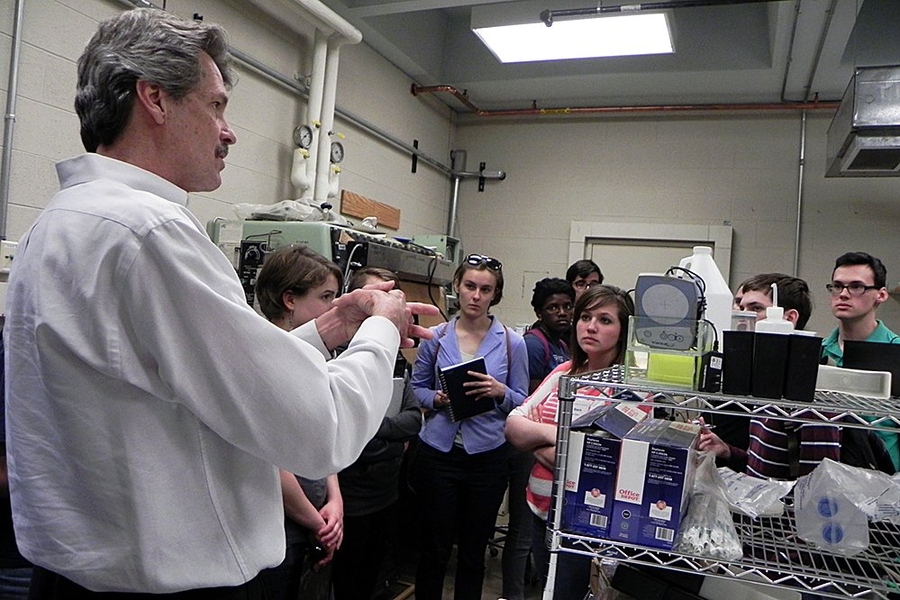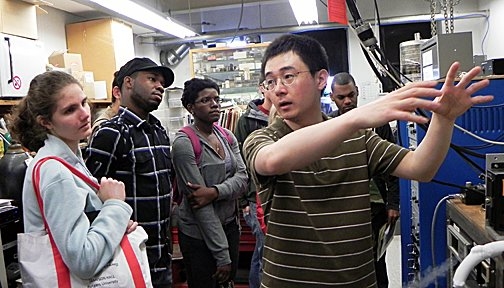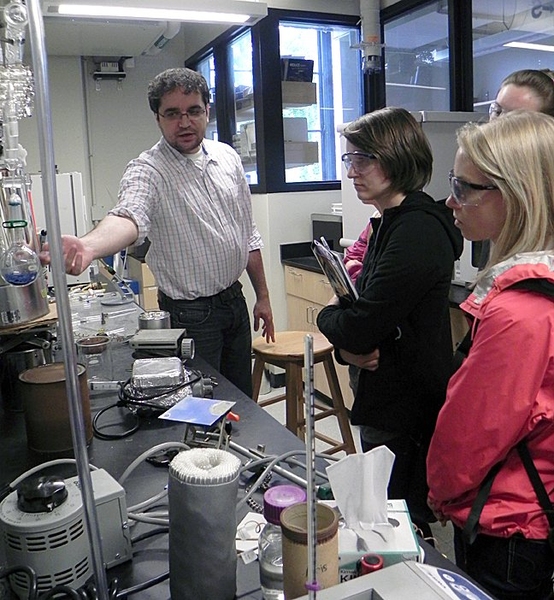Projects to understand the mechanics of spider webs, detect minute quantities of disease markers in fluid, and design stronger materials for 50-ton submarine rotor shafts are offering a path to research experience for 18 Summer Scholars through MIT’s Materials Processing Center and Center for Materials Science and Engineering. The summer interns — 15 seniors and three juniors from colleges in 14 states as well as Puerto Rico — picked their faculty lab affiliations in a 45-minute session on June 12, after three intensive days of on-campus presentations and lab tours by faculty and affiliated researchers.
Mila’na Jones, a chemistry and mathematics major from Xavier University, will be working in the Bioelectronics Group lab of Dr. Polina Anikeeva, AMAX Assistant Professor in Materials Science and Engineering. “For the experimental portion, I know that I’ll be synthesizing the particles, and then I get to characterize them and test them using some shared facilities and some of the facilities that she has in her lab,” Jones said.
In a presentation to the Summer Scholars, Michael Christiansen, a graduate student under Anikeeva, described the group’s work to develop minimally invasive ways to manipulate neurons, cells in the brain that resemble computers in their on-off character. The group is working with a form of iron oxide already approved for use in humans.
“It’s mostly experimental, but there’s also some modeling involved. I don’t really have any experience with computational work, so I’m kind of excited to learn what that’s like,” Jones said.
An oversupply of projects
With 21 presentations by faculty or their representatives for just 18 students, three were bound to be left out. In fact, some faculty presented up to four different possible summer projects for the students, but each student could be matched with only one project and each faculty member with only one student. “People recognize that the students we have in this program are very high quality and they deliver excellent work almost all the time, and they’re disappointed when their research project is not selected, but they come back each year. Sometimes they hit, sometimes they don’t,” Materials Science Professor Michael F. Rubner said. “A lot of our faculty would love to get two or three of these students, but that’s not the deal.”
Now in its 31st year, the Summer Scholars program has been run jointly for two decades by the Center for Materials Science and Engineering (CMSE) and the Materials Processing Center (MPC) at MIT, and it is an annual capstone event for the MPC. The program follows a nine-month cycle beginning in December with invitations to apply to college sophomores and juniors in the U.S. and Puerto Rico, concluding with the student-led research poster session in August. “One of the most rewarding aspects of the program for me is to witness the transformation of students who become highly knowledgeable and quite competent in a unique area of research and who see the value from their own contributions in just nine weeks,” said Mark Beals, MPC associate director. “We have many students who participated in this program continue their education at the graduate level at MIT, launch new companies and a few who become professors at MIT.”
Rubner, who also is director of CMSE, a federally funded Materials Research Science and Engineering Center, said the majority of funds supporting the Research Experiences for Undergraduates (REU) program are through the National Science Foundation. MPC covers student travel costs, staff time and some meeting expenses with its funds provided from the MPC Industry Collegium member fees.
Matching student hopes
Several students spoke of their hopes during the on-campus tours. “I want to make sure I that I don’t do things that I’ve done before,” said Jacob McAlpin, a materials chemistry major from Louisiana State University, who did photolithography at a lab last summer. He was paired with the lab of Assistant Professor of Materials Science and Engineering Michael J. Demkowicz. The work will involve molecular dynamics simulation of defects in polycrystals, graduate student Guoqiang Xu explained. Xu said the group hopes to find a structure with super properties by using computer simulations of stress and strain in physical movements of atoms and molecules.
“I like the whole thing with patterns; it’s just a mix; I like computational stuff, ” said Joanna Denton, a chemistry major from the University of West Georgia. Denton was paired with Toyota Professor of Materials Science and Engineering Caroline A. Ross, who also is associate department head for Materials Science and Engineering. In her presentation, Ross talked about her project to develop new nanostructured magnetic oxide films for memory and logic devices.
“It is an interesting field, especially the whole interplay between magnetics and electric current. I think it’s really cool because they’re governed by a similar equation,” Denton added. “I think it will just be interesting to see how they are related.”
Kari Kusler, a University of North Dakota chemistry major, was leaning toward a spider silk block co-polymer study with graduate student Anna Tarakanova in the Laboratory for Atomistic and Molecular Mechanics of Associate Professor Markus J. Buehler (Civil and Environmental Engineering). “It’s kind of hard to decide; we’ve seen so many projects, it’s a little overwhelming, but I think I’d be happy in most of these labs, so it’s not a big problem to decide really, even if I don’t get my first choice.” Ultimately, Kusler did get her first choice: the Buehler lab.
Robert Ramirez, a chemical engineering and applied mathematics major who is transferring from Washington University in St. Louis to Columbia University as a junior, was paired with Mitsui Career Development Assistant Professor Cullen R. Buie’s Laboratory for Energy and Microsystems Innovation (LEMI). Their project will involve functional thin films with properties to strongly repel water or strongly attract water. Fourth-year graduate student Youngsoo Joung made the group’s presentation. “He talked about fire resistance also,” Ramirez said. “He seemed like he was going to go in a lot of different directions with those and that sounded really interesting because I’m into national security research, and I think those could have a lot of applications in the future for various defense things.”
A unique selection process
Rather than pitting the students against each other, the selection process teaches them to negotiate with each other and “it works beautifully,” Rubner said.
“I think the uniqueness of our program here compared to many other REU programs across the country is the fact that we march in front of the students all of these projects from many, many different faculty, and we let the students decide where they go rather than placing them in a faculty lab or letting the faculty choose the ones they want,” Rubner said.
This year’s Summer Scholars arrived on campus June 9. The program ends August 10.
The list of summer scholars and faculty assignments follows:
Joseph Andrade – Dr. Jagadessh Moodera, Physics
Megan Beck – Prof. William Tisdale, Chemical Engineering
Raul Calzada – Prof. Mircea Dinca, Chemistry
Scott Danielson – Prof. Michael Rubner, Materials Science
Felix Elias – Prof. Alfredo Alexander-Katz, Materials Science
Joanna Denton – Prof. Caroline Ross, Materials Science
Wendy Feinstein – Prof. Yuriy Roman, Chemical Engineering
Sarah Goodman – Dr. Anu Agarwal, Materials Processing Center
James Haynes – Prof. Ron Ballinger, Nuclear Science
Mila'na Jones – Prof. Polina Anikeeva, Materials Science
Kari Kusler – Prof. Markus Buehler, Civil and Environmental Engineering
David Mackanic – Prof. Paula Hammond, Chemical Engineering
Jacob McAlpin – Prof. Michael Demkowicz, Materials Science
Alvin Mercedes – Prof. Gang Chen, Mechanical Engineering
Rachel Philiph – Prof. Karl Berggren, Electrical Engineering and Computer Science
Robert Ramirez – Prof. Cullen Buie, Mechanical Engineering
Stephanie Tzouanas – Prof. Michael Cima, Materials Science/Koch Institute
Emma Vander Ende – Prof. Michael Strano, Chemical Engineering
Mila’na Jones, a chemistry and mathematics major from Xavier University, will be working in the Bioelectronics Group lab of Dr. Polina Anikeeva, AMAX Assistant Professor in Materials Science and Engineering. “For the experimental portion, I know that I’ll be synthesizing the particles, and then I get to characterize them and test them using some shared facilities and some of the facilities that she has in her lab,” Jones said.
In a presentation to the Summer Scholars, Michael Christiansen, a graduate student under Anikeeva, described the group’s work to develop minimally invasive ways to manipulate neurons, cells in the brain that resemble computers in their on-off character. The group is working with a form of iron oxide already approved for use in humans.
“It’s mostly experimental, but there’s also some modeling involved. I don’t really have any experience with computational work, so I’m kind of excited to learn what that’s like,” Jones said.
An oversupply of projects
With 21 presentations by faculty or their representatives for just 18 students, three were bound to be left out. In fact, some faculty presented up to four different possible summer projects for the students, but each student could be matched with only one project and each faculty member with only one student. “People recognize that the students we have in this program are very high quality and they deliver excellent work almost all the time, and they’re disappointed when their research project is not selected, but they come back each year. Sometimes they hit, sometimes they don’t,” Materials Science Professor Michael F. Rubner said. “A lot of our faculty would love to get two or three of these students, but that’s not the deal.”
Now in its 31st year, the Summer Scholars program has been run jointly for two decades by the Center for Materials Science and Engineering (CMSE) and the Materials Processing Center (MPC) at MIT, and it is an annual capstone event for the MPC. The program follows a nine-month cycle beginning in December with invitations to apply to college sophomores and juniors in the U.S. and Puerto Rico, concluding with the student-led research poster session in August. “One of the most rewarding aspects of the program for me is to witness the transformation of students who become highly knowledgeable and quite competent in a unique area of research and who see the value from their own contributions in just nine weeks,” said Mark Beals, MPC associate director. “We have many students who participated in this program continue their education at the graduate level at MIT, launch new companies and a few who become professors at MIT.”
Rubner, who also is director of CMSE, a federally funded Materials Research Science and Engineering Center, said the majority of funds supporting the Research Experiences for Undergraduates (REU) program are through the National Science Foundation. MPC covers student travel costs, staff time and some meeting expenses with its funds provided from the MPC Industry Collegium member fees.
Matching student hopes
Several students spoke of their hopes during the on-campus tours. “I want to make sure I that I don’t do things that I’ve done before,” said Jacob McAlpin, a materials chemistry major from Louisiana State University, who did photolithography at a lab last summer. He was paired with the lab of Assistant Professor of Materials Science and Engineering Michael J. Demkowicz. The work will involve molecular dynamics simulation of defects in polycrystals, graduate student Guoqiang Xu explained. Xu said the group hopes to find a structure with super properties by using computer simulations of stress and strain in physical movements of atoms and molecules.
“I like the whole thing with patterns; it’s just a mix; I like computational stuff, ” said Joanna Denton, a chemistry major from the University of West Georgia. Denton was paired with Toyota Professor of Materials Science and Engineering Caroline A. Ross, who also is associate department head for Materials Science and Engineering. In her presentation, Ross talked about her project to develop new nanostructured magnetic oxide films for memory and logic devices.
“It is an interesting field, especially the whole interplay between magnetics and electric current. I think it’s really cool because they’re governed by a similar equation,” Denton added. “I think it will just be interesting to see how they are related.”
Kari Kusler, a University of North Dakota chemistry major, was leaning toward a spider silk block co-polymer study with graduate student Anna Tarakanova in the Laboratory for Atomistic and Molecular Mechanics of Associate Professor Markus J. Buehler (Civil and Environmental Engineering). “It’s kind of hard to decide; we’ve seen so many projects, it’s a little overwhelming, but I think I’d be happy in most of these labs, so it’s not a big problem to decide really, even if I don’t get my first choice.” Ultimately, Kusler did get her first choice: the Buehler lab.
Robert Ramirez, a chemical engineering and applied mathematics major who is transferring from Washington University in St. Louis to Columbia University as a junior, was paired with Mitsui Career Development Assistant Professor Cullen R. Buie’s Laboratory for Energy and Microsystems Innovation (LEMI). Their project will involve functional thin films with properties to strongly repel water or strongly attract water. Fourth-year graduate student Youngsoo Joung made the group’s presentation. “He talked about fire resistance also,” Ramirez said. “He seemed like he was going to go in a lot of different directions with those and that sounded really interesting because I’m into national security research, and I think those could have a lot of applications in the future for various defense things.”
A unique selection process
Rather than pitting the students against each other, the selection process teaches them to negotiate with each other and “it works beautifully,” Rubner said.
“I think the uniqueness of our program here compared to many other REU programs across the country is the fact that we march in front of the students all of these projects from many, many different faculty, and we let the students decide where they go rather than placing them in a faculty lab or letting the faculty choose the ones they want,” Rubner said.
This year’s Summer Scholars arrived on campus June 9. The program ends August 10.
The list of summer scholars and faculty assignments follows:
Joseph Andrade – Dr. Jagadessh Moodera, Physics
Megan Beck – Prof. William Tisdale, Chemical Engineering
Raul Calzada – Prof. Mircea Dinca, Chemistry
Scott Danielson – Prof. Michael Rubner, Materials Science
Felix Elias – Prof. Alfredo Alexander-Katz, Materials Science
Joanna Denton – Prof. Caroline Ross, Materials Science
Wendy Feinstein – Prof. Yuriy Roman, Chemical Engineering
Sarah Goodman – Dr. Anu Agarwal, Materials Processing Center
James Haynes – Prof. Ron Ballinger, Nuclear Science
Mila'na Jones – Prof. Polina Anikeeva, Materials Science
Kari Kusler – Prof. Markus Buehler, Civil and Environmental Engineering
David Mackanic – Prof. Paula Hammond, Chemical Engineering
Jacob McAlpin – Prof. Michael Demkowicz, Materials Science
Alvin Mercedes – Prof. Gang Chen, Mechanical Engineering
Rachel Philiph – Prof. Karl Berggren, Electrical Engineering and Computer Science
Robert Ramirez – Prof. Cullen Buie, Mechanical Engineering
Stephanie Tzouanas – Prof. Michael Cima, Materials Science/Koch Institute
Emma Vander Ende – Prof. Michael Strano, Chemical Engineering








